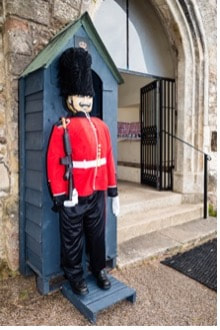Our Churchyards
Information about the Churchyards
There is an “Our Churchyards” noticeboard in the Church providing information about the Churchyards plus a shelf holding the folders with details about the memorials.
Maintenance of our Churchyards
We have entered every CPRE Devon's Best Churchyard competition - six years running:
We have been successful in this competition due to the hard work of all our volunteers and are the only church to have won an award in all six years of the competition!
- in 2018, we were “Runner Up”;
- in 2019, we won "Devon's Best Churchyard";
- in 2020, we achieved "Highly Commended";
- in 2021, we received a "Certificate of Excellence" in recognition of the great work that we do here;
- in 2022, we were awarded a “Certificate of Commendation” in recognition of our continuing good work; and
- in 2023, we were awarded an “Exemplary Award for Consistently High Achievement” in recognition of our work over the six years and “it’s very, very difficult to fault them” - Ivan Buxton, Head Judge.
We have been successful in this competition due to the hard work of all our volunteers and are the only church to have won an award in all six years of the competition!
If you want to know more about how we manage the Churchyards, you can download our current Management Plan here
If you want to know more about the Churchyard Working Party, please click here
Self-guided Trail
Between April and October, we have a self-guided trail through the Churchyards highlighting both wildlife and memorials, as well as how the Churchyards are managed. You can pick up a copy in the church porch.
Memorials
We have an extensive list of the memorials in our Churchyards that includes the names of people and other basic information, eg, dates, relationships and positions held. The large white folder has the memorials in the Old Churchyard around the Church; the black folder has the records for the New Churchyard and Garden of Remembrance. Both folders are by the “Our Churchyards” noticeboard in the Church.
We are recording all the inscriptions on the memorials and updating our records.
If you are looking for more information about the memorials and/or people buried in the Churchyards - please contact us using the details below.
We are recording all the inscriptions on the memorials and updating our records.
If you are looking for more information about the memorials and/or people buried in the Churchyards - please contact us using the details below.
Paul and Penny Kurowski: 01395 742942.
Email: [email protected]
Email: [email protected]
Some of the notable people buried in our Churchyards
William Edward Torriano
William Edward Torriano was born on the 14 July 1793 in Mount Roy, Wells, Somerset: he was the third son of Capt. Charles Torriano and Hester de la Fausille, and brother of Charles Strangeways Torriano (1790-1873). Both brothers had military careers. William entered the Seventy First Regiment (Highland Infantry Regiment) and served from July 1811 - April 1814 in the Peninsular War (Napoleonic wars) under the Duke of Wellington. He was present at Arroyo dos Molinos, Almarez, Vittoria (wounded), Nivelle, Nive (wounded), Bayonne (wounded), Orthes and at Toulouse. He received the Military General Service Medal (MGSM) retrospectively for Vittoria, Nivelle, Nive, Orthes and at Toulouse.
William was also at the battle of Waterloo and received the Waterloo Medal. Towards the end of the battle a group of soldiers from the 1st battalion of the 71st Regiment under his command captured one of the French cannon and turned it on the retreating imperial guard. This was said to be the last French cannon fired on the day - 18th June 1815. He was subsequently present at the surrender of Paris and stayed with the Army of Occupation in France. He retired from the service in May 1824.
William married Georgina Sophie Hunt, widow of Capt. James Hunt, on 20 October 1836, at the British Embassy Chapel in Paris, Seine, France. They were living in Fore Street, Salterton in 1841 but they appear to be absent from the 1851 and 1861 British censuses so may have been abroad. They left no children. William died in Budleigh Salterton on 5th February 1862, probate granted to Georgiana Sophia Torriano, 30 Apr 1862, Exeter, Devon, and Georgiana died in Menton, on the French Riviera, in 1878.
James Lackington
James Lackington was born on 31st August 1746 in Scott's Lane, Wellington, in Somerset, about 40 miles from Budleigh Salterton. He was the son of George, journeyman shoemaker, and Joan, the daughter of a weaver. His father became a habitual drinker and died young, leaving his widow to become a total abstainer and look after 11 children, of whom James was the eldest.
He started his apprenticeship at 14½ with a shoemaker in Taunton. When young, he learned to read the New Testament and converted to the newly formed Methodist movement in 1762. He married a dairymaid, Nancy Smith, from North Petherton in Somerset in 1768/1779. He loved collecting books and, having moved to London, in June 1774 he let a shop and parlour and started selling books; and his empire grew.
Nancy died in 1775; he married again on 30th January 1776, a Miss Dorcas Turton, who had been a school mistress and a keen reader and lover of books. She helped him run his business. By 1791, sales reached 100,000 a year and profits £4000 a year. In 1794, he opened the "Temple of the Muses" in Finsbury Square, London, which was the biggest bookshop in England and probably the cheapest as he believed in selling many books at a modest profit, rather than a few at a higher price.
Dorcas died in January 1795; however, by June, he was married for the third time, to Mary Turton, aged 29, the cousin of his late wife. He retired in 1798 when in his fifties. In 1806, he moved to Taunton and helped finance a new Wesleyan Methodist chapel “The Temple”.
He became one of the earliest inhabitants in Budleigh Salterton where he built his third "Temple" in 1812 (this was replaced in 1904-5 by the present church). He died, one source says of apoplexy, and is buried in the churchyard at East Budleigh, where his grave is marked by a simple inscription: "Sacred to the Memory of James Lackington who died at Budleigh Salterton November 25th. 1815 aged 70 years.”.
Mrs. Mary Lackington …
On the memorial, space was left for his wife Mary …; however, according to Miss Maria Gibbons of Budleigh Salterton in her book “We Donkeys in Devon" in the 1880s stated "Mrs Lackington was 7 times engaged, (made) 6 appearances at the altar, and 5 occasions actually married.”
"On 6th March 1817 she became Mrs William Symes. He died in 1822, aged 49, and lies in an unmarked grave in East Budleigh Churchyard."
On 29th October 1822 she became Mrs George Gellard (or Gilard). He died in 1833, aged 63, and lies in an unmarked grave in East Budleigh Churchyard.
On 5th December 1834 she became Mrs John Snow Manley. He too died, in 1840 aged 63, and lies in an unmarked grave in East Budleigh.
She left Budleigh Salterton, said to be aged 70 to move to apartments near the Cathedral in Exeter. She became attached to a young shopman who threw up his situation. She did not marry him, thinking he was too young, but gave him £50 in lieu of doing so.
Lastly a Mr Alexander Huddy journeyed to Exeter from St Clement, Cornwall, and she married him in 1841, and they lived together in the apartments. Then they moved to his Cornish home but it did not please her, and without consulting him, she drove back to Exeter. By advice of her lawyer, they separated and she gave him "£50 p.a. as long as she lived."
Mary Huddy died on 1st January 1850, aged 85, and her husband in the following year.
George William Preedy
George William Preedy was born in 1817 - the son of Robert and Anna (née Guy) Preedy of Hampton, Worcestershire. He entered the Royal Navy on 12 November 1828 and was promoted to Lieutenant (1844), Commander (1853) and Captain on 29 September 1855.
From 31 March to 1 September 1858 he was the Captain of HMS Agamemnon, laying the first Transatlantic cable - several attempts had been made in 1857 and early 1858. The final attempt started on 12 June 1858. After several challenges, eg, the worst ever Atlantic storms recorded, the cable broke three times, and a whale swam over the cable, HMS Agamemnon, together with the American Navy's USS Niagara, finally laid the first successful telegraph cable across the Atlantic. On 11 August 1858 The Times, newspaper reported: “England and the New World has at last been connected by the electric chain.” Celebrations in London were low-key but wildly extravagant in New York and San Francisco.
The Victorian “Internet” had been born and on 16 August Queen Victoria and President James Buchanan exchanged greetings in telegraphic messages.
On retirement in 1874, he was promoted to Rear-Admiral and on 30 January 1879 to Vice-Admiral on the Retired List. The Preedy family moved to Budleigh Salterton around 1878.. In the 1881 Census, he was living in a fine Victorian villa “Park House”, Park Lane, in Little Knowle, with his wife Elizabeth and three daughters, his older sister and four domestic staff. In 1891, the family was still in Park House, a son had returned and there were five domestic staff. He died 1894, aged 77 years, and was buried on 6 June.
There is a stained-glass window commemorating his captaincy of the HMS Agamemnon laying the Transatlantic cable on the left-hand side of the Choir just behind the rood screen in the Church. The image depicts the Gospel of St Mark’s account of Christ calming the stormy waters of the Sea of Galilee.
William Edward Torriano was born on the 14 July 1793 in Mount Roy, Wells, Somerset: he was the third son of Capt. Charles Torriano and Hester de la Fausille, and brother of Charles Strangeways Torriano (1790-1873). Both brothers had military careers. William entered the Seventy First Regiment (Highland Infantry Regiment) and served from July 1811 - April 1814 in the Peninsular War (Napoleonic wars) under the Duke of Wellington. He was present at Arroyo dos Molinos, Almarez, Vittoria (wounded), Nivelle, Nive (wounded), Bayonne (wounded), Orthes and at Toulouse. He received the Military General Service Medal (MGSM) retrospectively for Vittoria, Nivelle, Nive, Orthes and at Toulouse.
William was also at the battle of Waterloo and received the Waterloo Medal. Towards the end of the battle a group of soldiers from the 1st battalion of the 71st Regiment under his command captured one of the French cannon and turned it on the retreating imperial guard. This was said to be the last French cannon fired on the day - 18th June 1815. He was subsequently present at the surrender of Paris and stayed with the Army of Occupation in France. He retired from the service in May 1824.
William married Georgina Sophie Hunt, widow of Capt. James Hunt, on 20 October 1836, at the British Embassy Chapel in Paris, Seine, France. They were living in Fore Street, Salterton in 1841 but they appear to be absent from the 1851 and 1861 British censuses so may have been abroad. They left no children. William died in Budleigh Salterton on 5th February 1862, probate granted to Georgiana Sophia Torriano, 30 Apr 1862, Exeter, Devon, and Georgiana died in Menton, on the French Riviera, in 1878.
James Lackington
James Lackington was born on 31st August 1746 in Scott's Lane, Wellington, in Somerset, about 40 miles from Budleigh Salterton. He was the son of George, journeyman shoemaker, and Joan, the daughter of a weaver. His father became a habitual drinker and died young, leaving his widow to become a total abstainer and look after 11 children, of whom James was the eldest.
He started his apprenticeship at 14½ with a shoemaker in Taunton. When young, he learned to read the New Testament and converted to the newly formed Methodist movement in 1762. He married a dairymaid, Nancy Smith, from North Petherton in Somerset in 1768/1779. He loved collecting books and, having moved to London, in June 1774 he let a shop and parlour and started selling books; and his empire grew.
Nancy died in 1775; he married again on 30th January 1776, a Miss Dorcas Turton, who had been a school mistress and a keen reader and lover of books. She helped him run his business. By 1791, sales reached 100,000 a year and profits £4000 a year. In 1794, he opened the "Temple of the Muses" in Finsbury Square, London, which was the biggest bookshop in England and probably the cheapest as he believed in selling many books at a modest profit, rather than a few at a higher price.
Dorcas died in January 1795; however, by June, he was married for the third time, to Mary Turton, aged 29, the cousin of his late wife. He retired in 1798 when in his fifties. In 1806, he moved to Taunton and helped finance a new Wesleyan Methodist chapel “The Temple”.
He became one of the earliest inhabitants in Budleigh Salterton where he built his third "Temple" in 1812 (this was replaced in 1904-5 by the present church). He died, one source says of apoplexy, and is buried in the churchyard at East Budleigh, where his grave is marked by a simple inscription: "Sacred to the Memory of James Lackington who died at Budleigh Salterton November 25th. 1815 aged 70 years.”.
Mrs. Mary Lackington …
On the memorial, space was left for his wife Mary …; however, according to Miss Maria Gibbons of Budleigh Salterton in her book “We Donkeys in Devon" in the 1880s stated "Mrs Lackington was 7 times engaged, (made) 6 appearances at the altar, and 5 occasions actually married.”
"On 6th March 1817 she became Mrs William Symes. He died in 1822, aged 49, and lies in an unmarked grave in East Budleigh Churchyard."
On 29th October 1822 she became Mrs George Gellard (or Gilard). He died in 1833, aged 63, and lies in an unmarked grave in East Budleigh Churchyard.
On 5th December 1834 she became Mrs John Snow Manley. He too died, in 1840 aged 63, and lies in an unmarked grave in East Budleigh.
She left Budleigh Salterton, said to be aged 70 to move to apartments near the Cathedral in Exeter. She became attached to a young shopman who threw up his situation. She did not marry him, thinking he was too young, but gave him £50 in lieu of doing so.
Lastly a Mr Alexander Huddy journeyed to Exeter from St Clement, Cornwall, and she married him in 1841, and they lived together in the apartments. Then they moved to his Cornish home but it did not please her, and without consulting him, she drove back to Exeter. By advice of her lawyer, they separated and she gave him "£50 p.a. as long as she lived."
Mary Huddy died on 1st January 1850, aged 85, and her husband in the following year.
George William Preedy
George William Preedy was born in 1817 - the son of Robert and Anna (née Guy) Preedy of Hampton, Worcestershire. He entered the Royal Navy on 12 November 1828 and was promoted to Lieutenant (1844), Commander (1853) and Captain on 29 September 1855.
From 31 March to 1 September 1858 he was the Captain of HMS Agamemnon, laying the first Transatlantic cable - several attempts had been made in 1857 and early 1858. The final attempt started on 12 June 1858. After several challenges, eg, the worst ever Atlantic storms recorded, the cable broke three times, and a whale swam over the cable, HMS Agamemnon, together with the American Navy's USS Niagara, finally laid the first successful telegraph cable across the Atlantic. On 11 August 1858 The Times, newspaper reported: “England and the New World has at last been connected by the electric chain.” Celebrations in London were low-key but wildly extravagant in New York and San Francisco.
The Victorian “Internet” had been born and on 16 August Queen Victoria and President James Buchanan exchanged greetings in telegraphic messages.
On retirement in 1874, he was promoted to Rear-Admiral and on 30 January 1879 to Vice-Admiral on the Retired List. The Preedy family moved to Budleigh Salterton around 1878.. In the 1881 Census, he was living in a fine Victorian villa “Park House”, Park Lane, in Little Knowle, with his wife Elizabeth and three daughters, his older sister and four domestic staff. In 1891, the family was still in Park House, a son had returned and there were five domestic staff. He died 1894, aged 77 years, and was buried on 6 June.
There is a stained-glass window commemorating his captaincy of the HMS Agamemnon laying the Transatlantic cable on the left-hand side of the Choir just behind the rood screen in the Church. The image depicts the Gospel of St Mark’s account of Christ calming the stormy waters of the Sea of Galilee.
All Saints' Churchyard Day
We hold a Churchyard Day in early June to coincide with Caring for God’s Acre’s “Love Your Burial Ground Week” and “Churches Count on Nature” - the week before the Scarecrow Festival.
In 2021, it included wildlife and history information, a mini-bug hunt, a nature trail, guided walks and refreshments.
In 2022, there was a Jubilee Treasure Hunt, flower displays in the Church, guided walks, light music in the Church and, as it was Devon Day, a selection of Devon cheeses and wines to taste.
2023 included opportunities to paint/draw/sketch, children’s painting, guided walks, a bric-a-brac sale, and refreshments.
In 2021, it included wildlife and history information, a mini-bug hunt, a nature trail, guided walks and refreshments.
In 2022, there was a Jubilee Treasure Hunt, flower displays in the Church, guided walks, light music in the Church and, as it was Devon Day, a selection of Devon cheeses and wines to taste.
2023 included opportunities to paint/draw/sketch, children’s painting, guided walks, a bric-a-brac sale, and refreshments.
Watch this space for 2024 …











